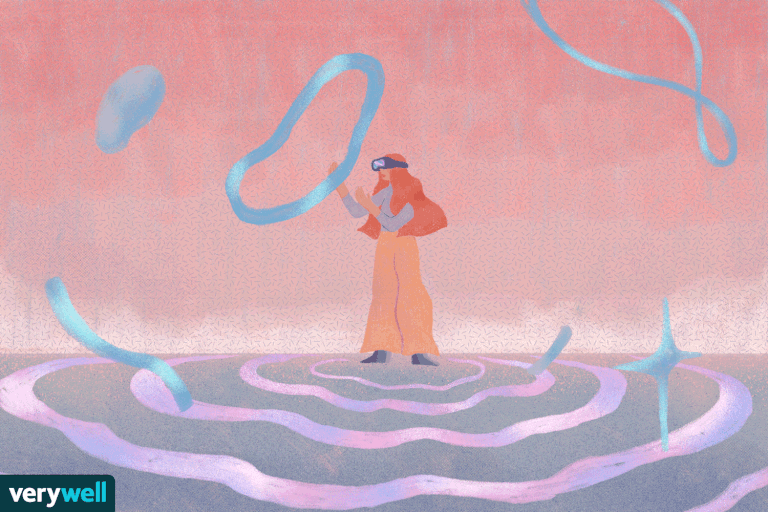
Anxiety disorders expressed by avoidance are among the most prevalent mental disorders. Exposure therapy is one of the key components in cognitive-behavioral treatment (CBT) for this problem. The concept of virtual reality could be a groundbreaking success in curing mental illnesses.
Virtual reality exposure therapy (VRET) allows patients who suffer from fear, anxiety, pain, phobias, brain injuries, addictions, and PTSD to enter a virtual world in which they are exposed to negative stimuli. The idea is to build resilience and emotional strength or distract the patient from their pain. The earlier a patient starts the easier it is to heal. Avoidance behavior can lead to an extreme so that it interferes with the quality of life.
The procedure
It is recommended to see a therapist first who helps you examine the origin and extent of your fears. Talk therapy should be the start of your treatment to prepare yourself for the upcoming experiences.
Embedded in a larger therapeutic treatment VRT is applied in different stages. Users wear a head-mounted display system (HMD) with binocular screens, stereo sound, and a movement-tracking method to follow the shifting VR environment and the user’s head movements. In many cases, the user can move with manual control when appropriate, feel vibrations through a platform, and be presented with olfactory stimuli through a scent machine that uses compressed air to diffuse scented substances.
The carefully designed virtual environment contains stimuli that have been associated with fear and in each state, those stimuli increase in appearance and intensity so that the patient’s body and mind can slowly adapt to the situations. In an exchange with your therapist, further modalities will be considered to cure you just right.

Cognitive-behavioral therapy
The efficiency of VRE goes beyond simpler anxiety disorders, given that studies performed with panic disorder, agoraphobia, and social anxiety disorders have also shown VRE to be effective [5].
Combining VRET with cognitive behavioral therapy can make up for profound and sustainable healing. VRET could also help to examine the fears you have in the first place when you’re unable to understand the origin. If a child for example suffers from a fear of school the virtual world can help the child express what exactly frightens him or her. Additionally, the therapist could then try to propose different actions the children could take if they are in such a situation [3].
Curing PTSD with VRET has especially shown an effect for Vietnam war veterans. Soldiers experienced a reduction in their PTSD syptoms after being exposed to various situations that provoke fear such as jungles, helicopters or fighting sceneries.
Advantages
- patient and therapist can share the exposure experience
- the option of applying exposure and control over the stimuli becomes available
- VR allows the therapist to individualize the exposure for each patient
- VRET facilitates the evoking of memories that may be difficult for the patient to relive by complementing those mental images with sensory cues
- VRET is especially attractive for the current generation geared towards digital technology
Disadvantages
- development of computer programs and the necessary computer equipment are costly
- the possibility of a system failure is always present and could interrupt a therapy session
- the therapist has to be trained to use a VR system
- VR concept itself may distract patients
- the amount of sensory stimulation that can be used in VR is limited by current existing technology
Outlook
Momentarily, VRET is not as prevalent due to its costs and simple newness. Very few therapists use VRET as of now, while the infrastructure is not expanded. Probably the availability of VR equipment will increase over time not only because of its benefits for psychic treatment but also for the general interest in other sectors, such as entertainment or education.
Clinical trials have repeatedly revealed that its effects persist after treatment and that it constitutes a valid alternative, or useful addition, to traditional exposure therapy. With the increasing prevalence of mental health assistance and the constant evolution of technology, the future possibilities for VR seem practically limitless.
References:
[1] https://www.verywellmind.com/thmb/8vmuGPcnzMem38aEvVjXYXJoBLc=/768×0/filters:no_upscale():max_bytes(150000):strip_icc():format(webp)/virtual-reality-exposure-therapy-vret-2797340-withlogo-5bf597033c454e9a8392c089ff01fbb2.gif
[2] https://www.digitalbodies.net/wp-content/uploads/2017/08/VR-Exposure-Therapy-Avenues.jpg
[3] https://www.betterhelp.com/advice/therapy/virtual-reality-therapy-a-therapeutic-use-of-technology/?utm_source=AdWords&utm_medium=Search_PPC_c&utm_term=_b&utm_content=118051370367&network=g&placement=&target=&matchtype=b&utm_campaign=11771068538&ad_type=text&adposition=&gclid=Cj0KCQiA6t6ABhDMARIsAONIYyzloY2rR_keagcV8gENHhSW-rGQXuNINVeiaIMEOcQUJuCZpwBP0qcaAs3xEALw_wcB
[4] https://www.verywellmind.com/virtual-reality-exposure-therapy-vret-2797340
[5] https://www.elsevier.es/en-revista-revista-psiquiatria-salud-mental-486-articulo-treating-anxiety-disorders-with-virtual-S2173505012000301